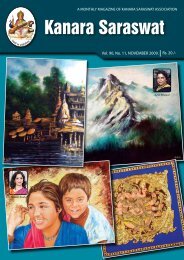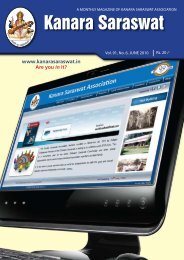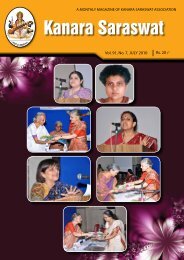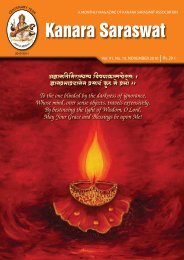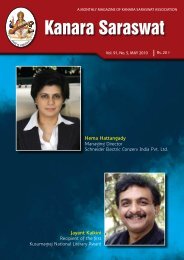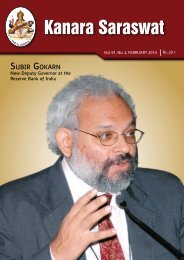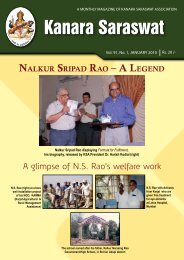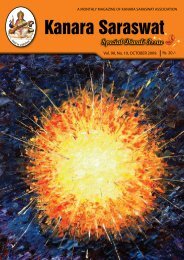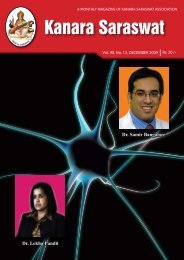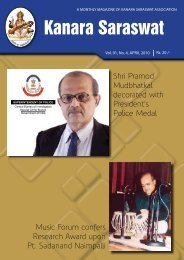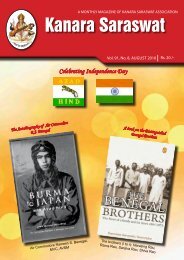Suma Kaushik, its Manager, thanked all those whohad helped fulfill PP Parijnanashram Swamiji’sdream. Poojya Sadyojat Shankashram Swamiji alsoaddressed the gathering.Konkani Culture: On the same day (24 th ), anenjoyable session took the shibirarthis on a journey,revisiting some <strong>of</strong> the intricacies <strong>of</strong> our mothertongue, which many <strong>of</strong> us were not very fluent in.We were first introduced to the “Amchi SurnamePictionary Game” in which volunteers from amongthe shibirarthis were given a Konkani surname andhad to draw a picture which would represent it as aKonkani or English word. This game was thoroughlyenjoyed by all. They then regaled the audience withsome traditional Amchi phrases or “mhanyo”.Games: Much-needed rest to our over-workedbrain cells, was provided by way <strong>of</strong> two extremelyinsightful games (24 th and 26 th December) which hadboth the young and the old participating actively.1. The Bedsheet Game – The shibirarthis weresplit into four tolis or groups – Audumber, Kadamb,Palash and Bilwa. Each toli was given a ball and abedsheet with five holes alongside which was acoloured patch. The objective was to navigate theball and make contact with all the coloured patchesnext to the holes while only holding the edge <strong>of</strong> thebedsheet. To increase the difficulty level, the gamewas replayed with two balls.2. Teamwork Game – Each toli was responsible forone letter <strong>of</strong> the word “AMCHI” and the objective<strong>of</strong> was to draw this letter in each <strong>of</strong> the 5 papersheets (stuck to the ground), using a box holding asketch pen at the bottom attached to which were 6ribbons, but by holding only the edge <strong>of</strong> the ribbons.Processing sessions at the end <strong>of</strong> each game helpedus to understand how we could relate the game toour real life. Both young and old participated veryenthusiastically; the energy displayed by the elderswas a joy to behold! The level <strong>of</strong> competitivenessreached was extraordinary and, at times, theshibirarthis needed to be reminded that it was “onlya game”.Sanskrit Sessions: Sanskrit sessions (25 th and27 th December) were facilitated by using a mixture<strong>of</strong> props and games. The sessions were conductedentirely in Sanskrit which, although challenged ourunderstanding at times, was well received and someshibirarthis showed an interest in learning Sanskritvia the notes on our Math website.Karaseva: For “Karaseva”, which literally means“service by hand”, the shibirarthis were taken toKembre farms where they had the opportunity toperform some unusual seva. They were split into twogroups - the first worked in an Acacia plantationwhere the shibirarthis had to rake in the fallendried leaves which prevent the rain water to seepthrough the ground to the roots. The second grouphad the task <strong>of</strong> smashing the rice shoots against thefarmer beds to separate the rice from the shoots (seephotograph above). Spread over the 25 th and 26 th ,the karaseva, although tiring, was quite a humblingexperience for many and made the shibirarthisappreciate some <strong>of</strong> the simple things <strong>of</strong> everyday life.Refreshed by an invigorating session <strong>of</strong> stretchingexercises, the shibirarthis performed their seva withabsolute sincerity and boundless enthusiam.Yuvadhara Presentations (25 th and 27 thDecember): Yuvadhara members made presentationson some <strong>of</strong> the Math’s activities. Madhura Haldipurspoke about the Srivali High School which catersto the students from the 8 th to 10 th standards.Kiran Gokarn then provided an insight into howSanskrit is slowly regaining its lost glory and howwe as Chitrapur Saraswats can avail <strong>of</strong> the teachingresources via Girvana Pratishtha, the Sanskritlearning arm <strong>of</strong> our Math. Esha Hoskote then spokeabout the praiseworthy work carried out by theSrivali Trust in helping the community in and aroundShirali. She also highlighted the importance <strong>of</strong> theSrivali Clinic and the exemplary work carried out bySamvit Sudha towards the upliftment and increasedindependence <strong>of</strong> the women around Shirali.Rahil Mundkur and Kartik Kadle gave a brieftalk on the concept <strong>of</strong> the Yuvadhara which hasbecome a huge success story in India, with a currentmembership <strong>of</strong> over 600 members countrywide.68Vol. 91, No.3, <strong>March</strong> <strong>2010</strong>Kanara Saraswat
The aim was to initiate a similar Yuvadhara inthe overseas Sabhas to reintroduce us to our richheritage and culture and pave the way for youngstersto contribute to our community.In the assigned window <strong>of</strong> two days, Rahil Mundkurand Kartik Kadle agreed to make the presentation,even though none <strong>of</strong> them were familiar with theentire content. It was truly a challenging task, wellaccomplished.Volunteering: The shibirarthis volunteered dailyin various Math activities such as bhojan seva (helpingserve food) and bhajan seva (singing bhajans) duringteerth vitaran and before Ratri Pooja.Quiz: Having spent the last four days learningabout our rich heritage, customs and illustrious GuruParampara, it was time to test our newly acquiredknowledge through a thoroughly informative andenjoyable quiz on Saraswat history, Konkani cultureand our sacred rituals, starting with the RoundRobin, followed by an audio-visual and a rapid fireround <strong>of</strong> ten questions. Each toli represented a teamand, as usual, the competition was fierce!Cultural Programme and Jali Beach Outing:On the final night (27 th December), the shibirarthisput up a wonderful cultural programme <strong>of</strong> groupperformances by each <strong>of</strong> the overseas Sabhaspresent as well as some outstanding individualperformances.The next morning, the Shibir finally concludedafter five wonderful days <strong>of</strong> learning, work and funwith an informal outing to Jali Beach. KrishnanandHeblekarmaam and his team deserve our thanks fortheir supreme efforts in making this Shibir a hugesuccess.Finally, with a sense <strong>of</strong> fulfilment and a promiseto return for the next NRI Shibir, the shibirarthisbade their goodbyes.The shibirarthis were indeed very fortunate tobe blessed with the presence <strong>of</strong> Poojya Swamijiduring the Shibir’s numerous activities and sessionsas well as during the interactions, both formal andinformal, when Poojya Swamiji patiently answeredall the questions no matter how frivolous or complexthe question seemed. Each shibirarthi would like tothank Him for His gracious presence and abundantpatience.———————————This is an abridged version <strong>of</strong> the report; the complete report isavailable on the website <strong>of</strong> Shree Chitrapur Math.‘Gulwadi Quartet’ performsin MauritiusNirmala Jaishankar (Bondal), Shobhana Rao(Ullal), Shaila Hattangadi and Arun Gulwadi,who perform as the sibling group ‘GulwadiQuartet’ are being accorded internationalrecognition for their talents. They had recentlybeen invited to perform a concert by theGovernment <strong>of</strong> Mauritius on the anniversary <strong>of</strong>their respected former leader Sir SeewoosagarRamgoolam.Raghuvir Vishveshwar Burde was felicitatedas the senior-most past pupil (born in 1914) <strong>of</strong>Gibb High School, Kumta, during the school’sCentenary Celebrations on December 19, 2009.He was blessed and honored by the pontiff, HHShrimad Vidyadhiraj Teerth Shripad Swamiji <strong>of</strong>Shri Samsthan Gokarn, Partagali Math. The threedayfunction was attended by dignitaries in thefield <strong>of</strong> education and key government <strong>of</strong>ficials <strong>of</strong>Karnataka and Goa.PHOTOGRAPHS IN KSWe have been trying to improve the quality <strong>of</strong>the photographs printed in our magazine and wouldappreciate your help.We request our all our contributors, advertisers and wellwisherswho send us photographs for printing to please - mail pr<strong>of</strong>essional quality prints <strong>of</strong> the photographs to:The Editor, at the KSA Office addressOR if using email, to scan the photographs at a minimumresolution <strong>of</strong> 300 dpi, and send them in .jpeg or .tif formatKanara Saraswat Vol. 91, No.3, <strong>March</strong> <strong>2010</strong>69
- Page 4 and 5:
Letters to theEditorDear Editor: Dr
- Page 6:
Besides medicine, Dr. Samsi had a l
- Page 12 and 13:
Dear Devotees,SHRIMATH ANANTHESHWAR
- Page 14 and 15:
80 GLORIOUS YEARSBIRTHDAY GREETINGS
- Page 16:
With best compliments fromPrecomp t
- Page 20 and 21: 18Vol. 91, No.3, March 2010Kanara S
- Page 22 and 23: 20Vol. 91, No.3, March 2010Kanara S
- Page 25 and 26: Kanara Saraswat Vol. 91, No.3, Marc
- Page 33 and 34: q 1980 Vw§ Canara Union, Bangalore
- Page 35 and 36: q J«m_rU {dH$mgmIm{Îma Karjat Far
- Page 37 and 38: and failure need not be a full stop
- Page 39 and 40: Kanara Saraswat Vol. 91, No.3, Marc
- Page 41 and 42: Nuest - 4 colour pages 1Kanara Sara
- Page 43 and 44: Nuest - 4 colour pages 3Kanara Sara
- Page 45 and 46: -: With Best Compliments from :-TUL
- Page 47 and 48: DIAMOND WEDDING ANNIVERSARY5 March
- Page 49 and 50: Dr. Aroon B. Samsi - A karmayogi pa
- Page 51 and 52: All for a fishy taleMeera S. Sa s h
- Page 53 and 54: Veteran classical singer Pandit Din
- Page 55 and 56: on the moon, he was so moved that h
- Page 57 and 58: Silent I (eye) witnessSu d h a Ph i
- Page 59 and 60: With Best WishesfromDivgiWarnerthe
- Page 61 and 62: Shrinath S. Shiralkar -First Chitra
- Page 63 and 64: ^amè`m _maV AgVmZm {Xgcm. gdmªZr
- Page 65 and 66: : With Compliments from :THENKASI R
- Page 67 and 68: Fame is...Mihika Pa i d h u n g atF
- Page 69: NRI Sanskriti Prachar Shibir - A Re
- Page 73 and 74: PersonaliaPankaj Kumta, 23, son of
- Page 75 and 76: Kanara Saraswat Vol. 91, No.3, Marc
- Page 77 and 78: Kanara Saraswat Vol. 91, No.3, Marc
- Page 79 and 80: The Punyatithi of HH Shankarashram
- Page 81 and 82: Saraswat Mahila Samaj, Gamdevi, Mum
- Page 83 and 84: Kanara Saraswat Vol. 91, No.3, Marc



